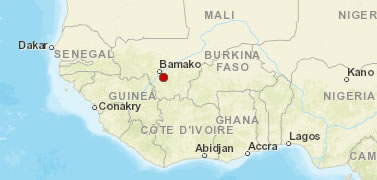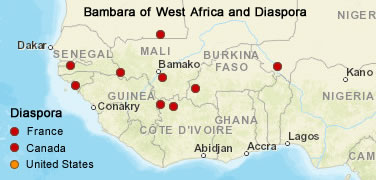People Groups: Counts
How many people groups are there? All depends on the counting method.
Traditional: Counting by country
This method counts a people group for each country it lives in. For example, the Bambara in Mali are considered a distinct people group. If the Bambara live in 12 countries they are counted as 12 people groups. Of the 16,382 people groups by country, 7,124 are considered unreached and 4,767 are frontier unreached.

Each dot is a people group.
12 Bambara people groups.
Alternative: Not consider country boundaries
This method counts a people group once regardless of how many countries they live in. For example, if the Bambara live in 12 countries they are counted as only one people group. Of the 10,415 people groups across countries, 4,486 are unreached and 3,203 are frontier unreached.

All dots together are considered one people group.
1 Bambara people group.
Usually called People Groups In Countries (PGIC) and has been the traditional way of counting people groups. This method was used when people group lists were first being developed. Geography i.e. country boundaries were included when defining people groups due to limited communication, expensive travel and minimal migration of peoples.
Usually called People Groups Across Countries (PGAC) and may be the preferred way of counting people groups. Given instant communications, easy travel and dramatic migration of peoples, it seems more relevant today to not consider country boundaries when defining people groups. Note: if a group is in only one country then PGAC = PGIC.
PGIC Challenges
- New People Groups In Countries (PGICs) are formed whenever a homeland group moves to a new country. This creates an ever expanding list as the number of PGICs is essentially unlimited.
- The number of unreached people groups appears to be increasing creating confusion due to constantly "moving goalposts".
- The largest homeland groups and the smallest diaspora groups are considered as equal and "disconnected" from each other.
- Geographic barriers and the “distance” between the homeland and the diaspora have significantly blurred, if not disappeared.
PGIC Benefits
- Familiar to users. Minimizes confusion over numbers.
- Consistency with historical people group numbers.
- Allows comparisons between lists that count by PGIC.
PGAC Challenges
- Confusion when comparing with historical numbers.
- Potential confusion of terminology. What does "people group" mean? PGIC or PGAC? Can only tell by context.
- Requires user re-education.
PGAC Benefits
- The People Groups Across Countries (PGAC) count is a stable number. New PGAC groups are rarely added.
- Elminates problem of constantly increasing number of unreached groups and "moving goalposts".
- Possibly the more Biblical method as current geopolitical boundaries did not exist when Jesus gave the Great Commission.
- Much higher agreement between various people group lists.
- Emphasizes the relationship between homeland and diaspora.
Both People Group In Country (PGIC) and People Group Across Countries (PGAC) views are available. In the title of any profile e.g. "Bambara in Mali" click "Bambara" for a list of Bambara in all countries.
The following video explains the traditional way of counting people groups (PGIC), its challenges and limitations and why a shift to considering people groups across countries (PGAC) is strategic.



